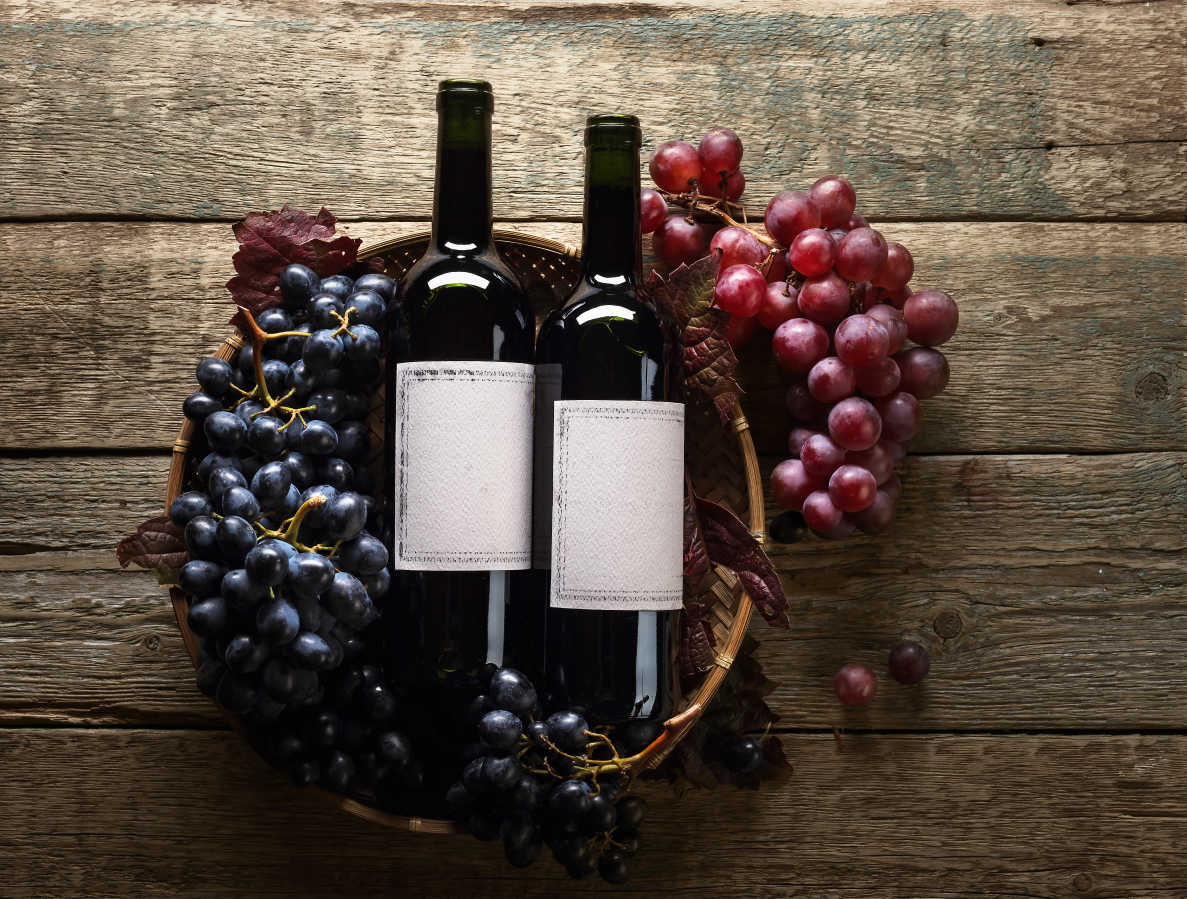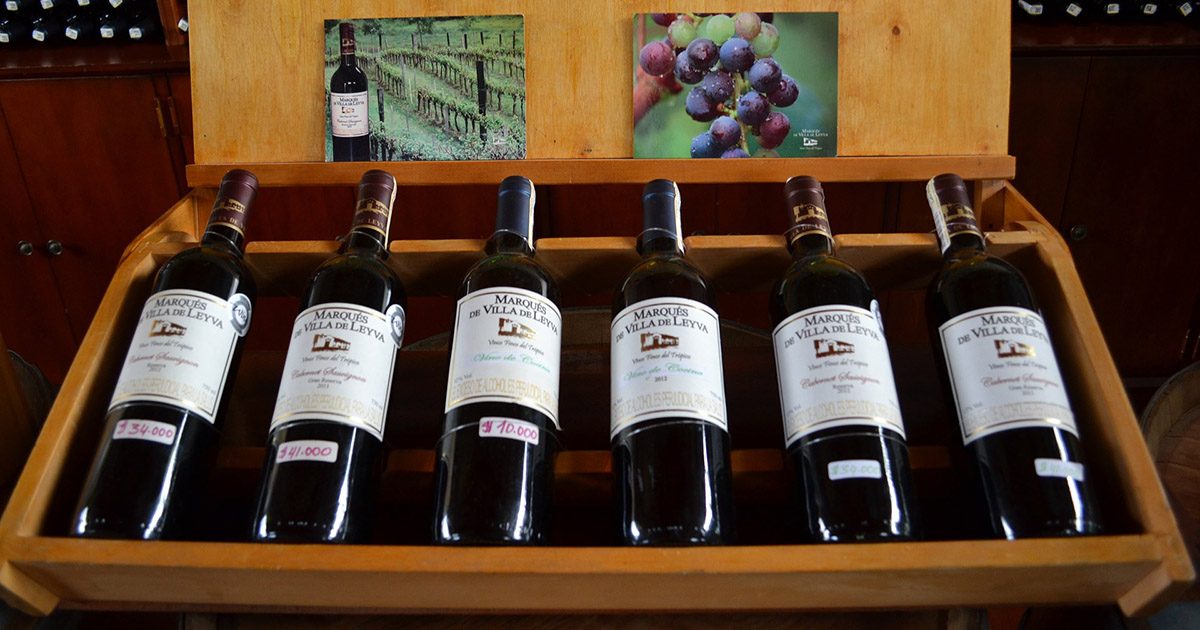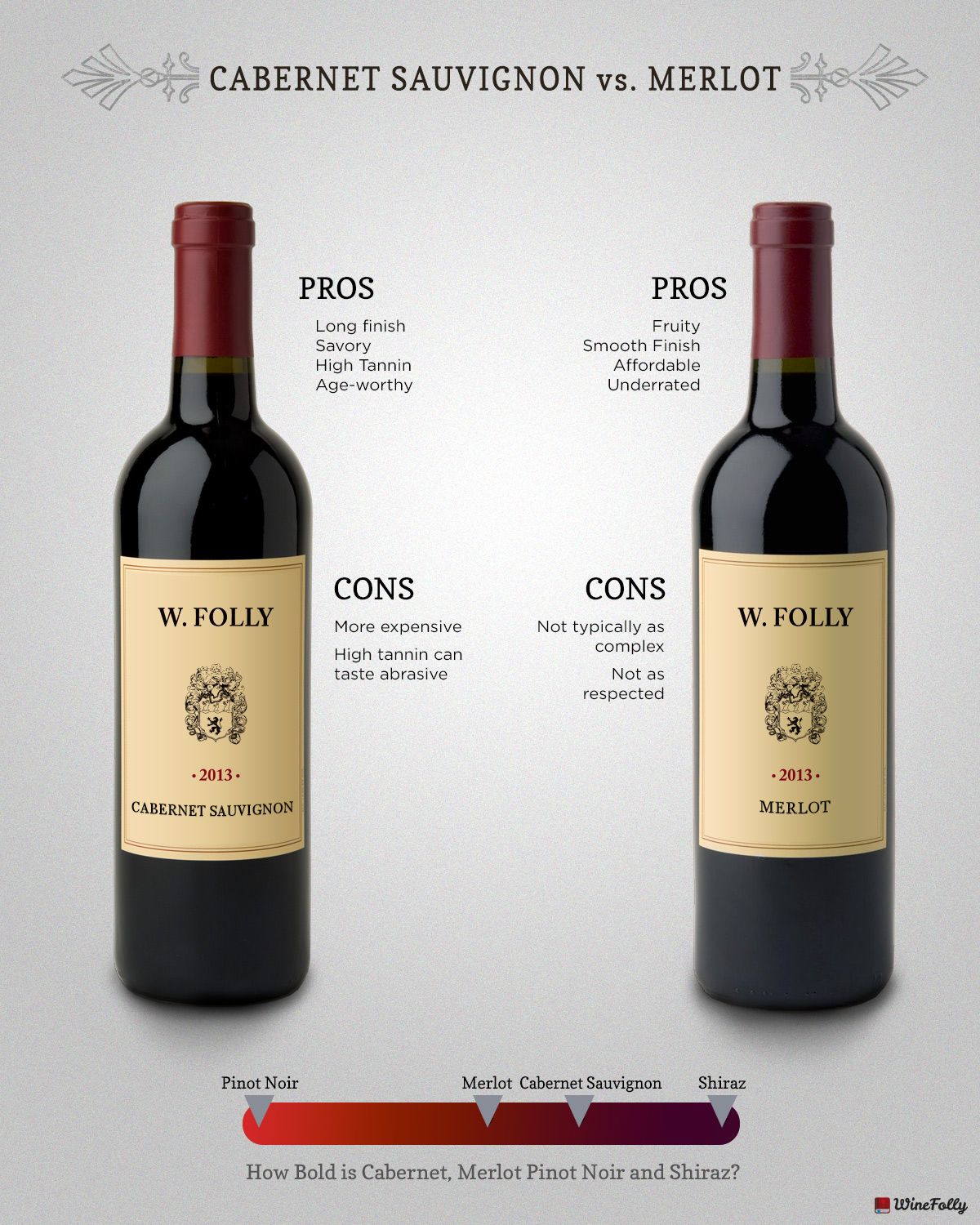Introduction

Red wine enthusiasts often find themselves choosing between two popular varieties: Cabernet Sauvignon and Merlot. Both wines have their own distinctive characteristics and flavors, making them unique choices for different occasions and palates. This article aims to provide an in-depth comparison of Cabernet Sauvignon and Merlot, highlighting the key differences between the two red wine varieties. Whether you’re a wine connoisseur or simply interested in expanding your knowledge, this article will help you understand the characteristics, tasting notes, and food pairing suggestions for Cabernet Sauvignon and Merlot. So, let’s dive into the world of these contrasting red wines and discover their true essence.
Overview Of Cabernet Sauvignon And Merlot
Cabernet Sauvignon and Merlot are two popular red wine varieties that offer distinct characteristics and flavors. Cabernet Sauvignon is known for its boldness, high tannins, and dark fruit flavors like blackberry and blackcurrant. It is often aged in oak barrels, which adds complexity and notes of vanilla and cedar. On the other hand, Merlot is known for its softer tannins, medium body, and flavors of ripe black cherries and plums. It is often described as more approachable and versatile. Both wines have a loyal following and can be enjoyed on their own or paired with a variety of foods.
Key Differences Between Cabernet Sauvignon And Merlot
When comparing Cabernet Sauvignon and Merlot, there are several key differences to consider. Here are some of the main distinctions between these two red wine varieties:
- Tannins: Cabernet Sauvignon generally has higher tannins than Merlot, which results in a more structured and firm mouthfeel.
- Flavor profile: Cabernet Sauvignon is known for its intense flavors of blackberry, blackcurrant, and cedar, while Merlot offers softer flavors of ripe black cherries and plums.
- Body: Cabernet Sauvignon typically has a fuller body compared to the medium-bodied nature of Merlot.
- Aging potential: Cabernet Sauvignon has a higher aging potential due to its higher tannin and acidity levels, whereas Merlot is often consumed at a younger age.
- Food pairing: Cabernet Sauvignon pairs well with bold and rich dishes like grilled steak and lamb, while Merlot is more versatile and can be enjoyed with a variety of foods, including roasted chicken and pasta dishes.
Overall, choosing between Cabernet Sauvignon and Merlot depends on personal preference and the occasion.
Cabernet Sauvignon Characteristics

Cabernet Sauvignon is known for its distinct characteristics that set it apart from other red wine varieties. It boasts a bold and full-bodied nature, with higher tannin levels that give it a firm and structured mouthfeel. The flavors of Cabernet Sauvignon are intense, featuring notes of blackberry, blackcurrant, and hints of cedar. This wine variety has a higher aging potential due to its higher tannin and acidity levels, allowing it to develop complex flavors over time. When paired with rich and bold dishes like grilled steak or lamb, Cabernet Sauvignon shines, making it a favorite choice for wine enthusiasts.
Cabernet Sauvignon Grape Profile And Flavor Notes
Cabernet Sauvignon grapes are known for their thick skins, which contribute to the wine’s intense flavors and high tannin levels. These grapes thrive in warmer climates and are grown in regions such as Bordeaux, Napa Valley, and Coonawarra. The flavor profile of Cabernet Sauvignon is characterized by dark fruit notes, such as blackberry and blackcurrant, with hints of cedar and tobacco. The wine’s bold and full-bodied nature, along with its pronounced acidity, adds complexity and structure. Cabernet Sauvignon has a long aging potential, allowing it to develop additional flavors and nuances over time.
Cabernet Sauvignon Food Pairing Suggestions
Cabernet Sauvignon is known for its bold flavors and high tannin levels, making it a perfect match for rich, hearty dishes. Here are some food pairing suggestions to enhance your Cabernet Sauvignon wine experience:
- Red Meat: Cabernet Sauvignon and red meat, such as beef, lamb, or venison, are a match made in heaven. The wine’s tannins cut through the meat’s richness and balance its fattiness.
- Aged Cheese and Hard Cheese: Cabernet Sauvignon pairs well with aged and hard cheeses, such as cheddar, Gouda, or Parmesan. The wine’s structure complements the bold flavors of the cheese.
These pairing suggestions will help elevate your dining experience and bring out the best in your Cabernet Sauvignon wine.
Merlot Characteristics

Merlot is a red wine grape variety known for its smooth and approachable characteristics. It typically produces wines with medium body and moderate tannins, making it a popular choice among wine enthusiasts. The grapes have a dark blue hue and a thinner skin compared to Cabernet Sauvignon, resulting in a wine with a deep red color. Merlot wines are known for their fruity flavors, such as black cherry, plum, and blackberry, as well as notes of cocoa and spice. They often have a velvety texture and a balanced acidity, making them easy to enjoy on their own or paired with a variety of dishes.
Merlot Grape Profile And Flavor Notes
Merlot grapes are known for their dark blue hue and thinner skin compared to Cabernet Sauvignon. This grape variety produces wines with medium body and moderate tannins, making it smooth and approachable. The flavor profile of Merlot often includes notes of black cherry, plum, and blackberry, as well as hints of cocoa and spice. The wine has a velvety texture and a balanced acidity, making it easy to enjoy on its own or paired with a variety of dishes. Merlot is known for its versatility and is grown in many wine-producing regions around the world.
Merlot Aging Potential And Versatility
Merlot wines have a moderate aging potential, typically ranging from 5 to 10 years. During this time, the flavors and aromas of Merlot develop and mature, providing a more complex and nuanced drinking experience. While Merlot can be enjoyed when young, aging allows the wine to soften and the tannins to integrate, resulting in a smoother texture.
In terms of versatility, Merlot shines in its ability to pair well with a variety of foods. Its medium body and balanced acidity make it a versatile companion to dishes such as roasted meats, grilled vegetables, and tomato-based pasta sauces. Whether enjoyed on its own or paired with food, Merlot offers a delightful drinking experience for wine enthusiasts.
Tasting Notes Comparison

When comparing the tasting notes of Cabernet Sauvignon and Merlot, noticeable differences arise. Cabernet Sauvignon is known for its bold and intense flavors, often displaying notes of blackcurrant, blackberry, and cedar. Its high tannin content gives it a firm structure and a long finish. On the other hand, Merlot offers more approachable and softer flavors, with hints of plum, cherry, and chocolate. Its medium body and lower tannins make it smoother on the palate. Overall, the tasting experience of Cabernet Sauvignon is bolder and more robust, while Merlot showcases a softer and more fruit-forward character.
Taste Comparison Between Cabernet Sauvignon And Merlot
Cabernet Sauvignon and Merlot offer distinct taste profiles. Cabernet Sauvignon is known for its bold and intense flavors, with a dominant presence of blackcurrant, blackberry, and cedar. It has a higher tannin content, which lends it a firm structure and a long, lingering finish. On the other hand, Merlot is characterized by softer and more approachable flavors of plum, cherry, and chocolate. It has a smoother texture on the palate due to its lower tannin levels. These differences in taste make Cabernet Sauvignon more robust and intense, while Merlot is fruit-forward and easier to drink.
Aroma And Body Differences
Cabernet Sauvignon and Merlot also differ in terms of aroma and body. Cabernet Sauvignon typically has a more complex aroma, with notes of blackcurrant, blackberry, and cedar. It often has a fuller body with higher tannins, giving it a bold and robust character. On the other hand, Merlot has a softer and more approachable aroma, with hints of plum, cherry, and chocolate. It has a smoother texture and lower tannin levels, resulting in a wine that is more fruit-forward and easier to drink. These differences contribute to the unique profiles and overall experience of each wine.
Popular Regions And Brands

Popular regions for Cabernet Sauvignon production include the Napa Valley in California, Bordeaux in France, and Coonawarra in Australia. These regions are known for their ideal climate and terroir, which produce high-quality Cabernet Sauvignon grapes. Some notable Cabernet Sauvignon brands include Château Lafite Rothschild, Opus One, and Caymus Vineyards. On the other hand, Merlot is grown in regions such as Bordeaux, California, and Chile’s Central Valley. Popular Merlot brands include Château Pétrus, Duckhorn Vineyards, and Concha y Toro. These regions and brands offer a wide range of options for wine enthusiasts to explore and enjoy.
Notable Regions For Cabernet Sauvignon And Merlot Production
Cabernet Sauvignon and Merlot are grown in various regions around the world, each offering unique characteristics and flavors to the wines produced. Some notable regions for Cabernet Sauvignon production include the Napa Valley in California, Bordeaux in France, and Coonawarra in Australia. These regions are known for their ideal climate and terroir, which contribute to the exceptional quality of the Cabernet Sauvignon grapes. For Merlot, notable regions include Bordeaux, California, and Chile’s Central Valley. These regions also provide the perfect conditions for cultivating high-quality Merlot grapes, resulting in wines with rich flavors and elegant structures.
Recommended Cabernet Sauvignon And Merlot Brands
When it comes to choosing Cabernet Sauvignon and Merlot brands, there are several highly regarded options to consider. Some recommended Cabernet Sauvignon brands include:
- Caymus Vineyards: Known for their rich and powerful Cabernet Sauvignon from Napa Valley, Caymus Vineyards has garnered a loyal following with their consistently impressive wines.
- Silver Oak: With a focus on producing distinctive Cabernet Sauvignon, Silver Oak is renowned for their elegant and structured wines that showcase the distinct characteristics of their respective regions, including Napa Valley and Alexander Valley.
For Merlot, some recommended brands include:
- Duckhorn Vineyards: Duckhorn Vineyards has become synonymous with excellent Merlot, with their wines offering a lush and velvety texture, balanced acidity, and complex flavors.
- Chateau Petrus: As one of the most prestigious and sought-after Merlot producers, Chateau Petrus from Bordeaux consistently produces exceptional wines with intense fruit flavors and a long, refined finish.
Keep in mind that these are just a few examples, and there are many other outstanding Cabernet Sauvignon and Merlot brands available in the market. It’s always recommended to explore different brands and regions to find the ones that suit your palate preferences.
Conclusion

In conclusion, Cabernet Sauvignon and Merlot are two notable red wine varieties that offer distinct characteristics and flavor profiles. Cabernet Sauvignon is known for its intense, full-bodied nature, with flavors of black currant and tobacco. On the other hand, Merlot is known for its softer and more approachable style, with notes of ripe fruit and velvety texture. Both wines have their merits and finding the right one for your palate ultimately comes down to personal preference. Whether you choose Cabernet Sauvignon or Merlot, you’re sure to enjoy the rich flavors and complexity that these wines have to offer.
Summary Of Key Differences And Similarities
When comparing Cabernet Sauvignon and Merlot, there are several key differences and similarities to consider.
Differences:
- Cabernet Sauvignon is known for its intense, full-bodied nature, while Merlot is softer and more approachable
- Cabernet Sauvignon has higher tannins and acidity compared to Merlot
- Cabernet Sauvignon typically offers flavors of black currant and tobacco, while Merlot showcases notes of ripe fruit
- Cabernet Sauvignon has a longer aging potential than Merlot
Similarities:
- Both wines are red and are made from specific grape varieties
- Cabernet Sauvignon and Merlot can be found in various wine regions around the world
- Both wines pair well with red meat and hearty dishes
Choosing Between Cabernet Sauvignon And Merlot
Choosing between Cabernet Sauvignon and Merlot ultimately comes down to personal preference and the occasion. If you prefer bold and robust flavors with higher tannins, Cabernet Sauvignon is the better choice. It pairs well with rich, hearty dishes and is great for special occasions. On the other hand, if you prefer softer, fruitier wines with lower tannins and acidity, Merlot is the way to go. It is more versatile and can be enjoyed on its own or paired with a variety of foods. Ultimately, both wines offer unique characteristics that can enhance any wine-drinking experience.
FAQ About Cabernet Sauvignon Vs Merlot: Contrasting Red Wine Varieties
Q: What is the primary difference between Cabernet Sauvignon and Merlot?
A: The main difference lies in their flavor profiles and tannin levels. Cabernet Sauvignon is known for its bold, rich taste and higher tannin content, while Merlot is generally softer with a fruit-forward character.
Q: Which wine pairs better with certain types of food?
A: Cabernet Sauvignon pairs well with red meats, hearty dishes, and aged cheeses due to its bold flavors and tannins. Merlot, on the other hand, complements poultry, pasta, and dishes with tomato-based sauces.
Q: Are there differences in the aging potential of Cabernet Sauvignon and Merlot?
A: Yes, Cabernet Sauvignon generally has a higher aging potential than Merlot due to its robust tannin structure. Cabernet Sauvignon wines can often benefit from extended aging to enhance their complexity.
Q: What are the typical aromas associated with Cabernet Sauvignon and Merlot?
A: Cabernet Sauvignon is known for aromas of dark fruits like blackberry and cassis, as well as notes of cedar and tobacco. Merlot typically displays aromas of red fruits such as cherry and plum, with hints of chocolate and herbs.
Q: Do Cabernet Sauvignon and Merlot differ in terms of ideal serving temperatures?
A: Yes, Cabernet Sauvignon is best served slightly warmer, around 60-65°F (15-18°C), to allow its flavors to open up. Merlot is typically served slightly cooler, between 55-60°F (13-15°C), to enhance its fruitiness and soften any tannins.
Q: What are the most famous regions for producing Cabernet Sauvignon and Merlot wines?
A: Cabernet Sauvignon is prominently grown in Bordeaux, France, as well as regions like Napa Valley in California and Coonawarra in Australia. Merlot is widely planted in Bordeaux, particularly on the Right Bank, as well as in regions like Tuscany, Italy, and Washington State in the United States.
